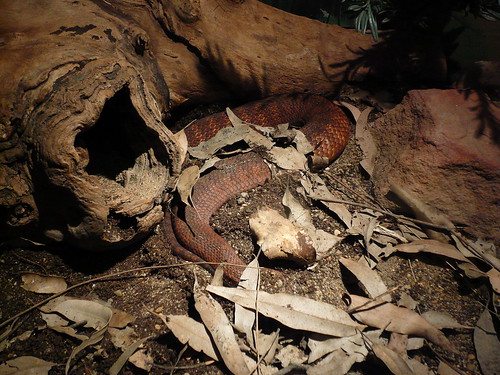The Desert Death Adder, Acanthophis pyrrhus, is a species of snake native to Australia and is one of the most venomous land snakes in the world. The Desert Death Adder is under threat due to the destruction of habitat.
Desert Deaths Adders are members of the Acanthophis genus, highly venomous elapids with short and thick bodies, triangular heads, mobile fangs, and a thin tapering tail. They grow to lengths up to 70 centimetres, with a snout to vent length of 62 cm, and have a flattened appearance. Desert Death Adders are coloured brick-red, or yellow-reddish, with strong or inconspicuous yellow bands which are camouflaged with their surroundings. The tail tip is used as a lure to attract potential prey and is distinctively darker in colour. Their fangs are longer than most of Australia’s venomous snakes.
The species was first described in 1898 by George Albert Boulenger.
The Desert Death Adder occurs from the coast of Western Australia, to central regions as far south as Kalgoorlie and into the Northern Territory. The related species, the Common or Southern Death Adder, is found in a different range.
Desert Death Adders are found in living in remote areas, amongst porcupine grass, stony flats, sandy ridges and rocky outcrops of Central and Western Australia. In southwest Australia they occur in hummock grass in mallee.
Desert Deaths Adders are members of the Acanthophis genus, highly venomous elapids with short and thick bodies, triangular heads, mobile fangs, and a thin tapering tail. They grow to lengths up to 70 centimetres, with a snout to vent length of 62 cm, and have a flattened appearance. Desert Death Adders are coloured brick-red, or yellow-reddish, with strong or inconspicuous yellow bands which are camouflaged with their surroundings. The tail tip is used as a lure to attract potential prey and is distinctively darker in colour. Their fangs are longer than most of Australia’s venomous snakes.
The species was first described in 1898 by George Albert Boulenger.
The Desert Death Adder occurs from the coast of Western Australia, to central regions as far south as Kalgoorlie and into the Northern Territory. The related species, the Common or Southern Death Adder, is found in a different range.
Desert Death Adders are found in living in remote areas, amongst porcupine grass, stony flats, sandy ridges and rocky outcrops of Central and Western Australia. In southwest Australia they occur in hummock grass in mallee.


No comments:
Post a Comment